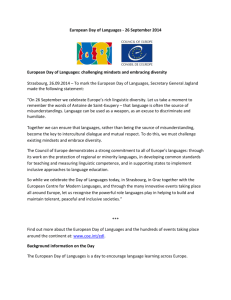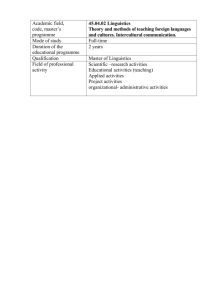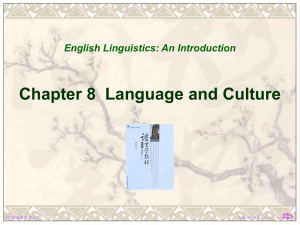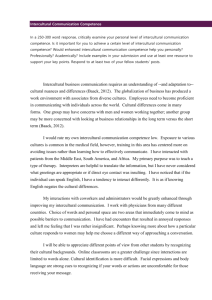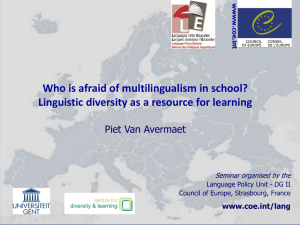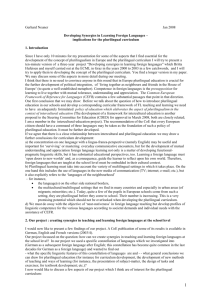3. Components of plurilingual and intercultural
advertisement
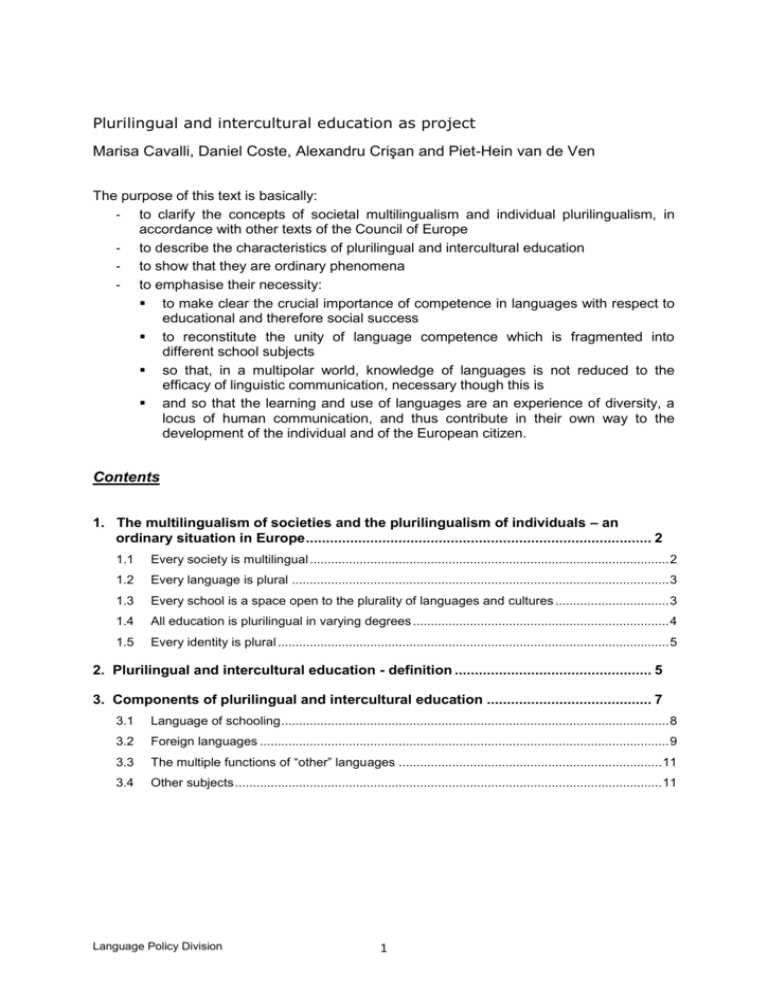
Plurilingual and intercultural education as project Marisa Cavalli, Daniel Coste, Alexandru Crişan and Piet-Hein van de Ven The purpose of this text is basically: - to clarify the concepts of societal multilingualism and individual plurilingualism, in accordance with other texts of the Council of Europe - to describe the characteristics of plurilingual and intercultural education - to show that they are ordinary phenomena - to emphasise their necessity: to make clear the crucial importance of competence in languages with respect to educational and therefore social success to reconstitute the unity of language competence which is fragmented into different school subjects so that, in a multipolar world, knowledge of languages is not reduced to the efficacy of linguistic communication, necessary though this is and so that the learning and use of languages are an experience of diversity, a locus of human communication, and thus contribute in their own way to the development of the individual and of the European citizen. Contents 1. The multilingualism of societies and the plurilingualism of individuals – an ordinary situation in Europe ...................................................................................... 2 1.1 Every society is multilingual ..................................................................................................... 2 1.2 Every language is plural .......................................................................................................... 3 1.3 Every school is a space open to the plurality of languages and cultures ................................ 3 1.4 All education is plurilingual in varying degrees ........................................................................ 4 1.5 Every identity is plural .............................................................................................................. 5 2. Plurilingual and intercultural education - definition ................................................. 5 3. Components of plurilingual and intercultural education ......................................... 7 3.1 Language of schooling ............................................................................................................. 8 3.2 Foreign languages ................................................................................................................... 9 3.3 The multiple functions of “other” languages .......................................................................... 11 3.4 Other subjects ........................................................................................................................ 11 Language Policy Division 1 1. The multilingualism of societies and the plurilingualism of individuals – an ordinary situation in Europe The first requirement in thinking about societal multilingualism and individual plurilingualism is to demystify the two concepts. We must strip away the aura of perfection, rarity and preciousness which still surrounds them. However tempting it may be, we must not believe that they apply only to very specific situations, that bilingual/plurilingual education is characteristic of only a small number of education systems based on very unusual policy and educational choices, usually of a minority and/or elitist nature, or that a plurilingual person is a rare individual possessing extraordinary abilities. Recognising the multilingualism of societies and the plurilingualism of individual speakers as commonplace means that our usual representations of these phenomena must change radically. For this to happen the everyday nature of multilingualism and plurilingualism must be acknowledged. This implies becoming aware of, and accepting, paradoxes which are more apparent than real and which show that, far from being exceptions, linguistic plurality and diversity are together part of everyday reality and of everybody's daily experience and that, quite simply, they are to be found on every street corner. A proper representation of multilingualism and plurilingualism therefore means that the data and arguments supporting the apparent paradoxes mentioned below must be recognised, accepted and made part of general awareness. 1.1 Every society is multilingual Every country has, as it were, its own multilingualism composed of "traditional" languages which form part of its cultural heritage. These include the national language(s) and its varieties, minority languages, regional languages or dialects. Such endogenous multilingualism may, in certain contexts, be the object not just of rejection but also of open hostility to even recognising it, in order to preserve the position of national languages. In addition to this “ordinary”, heritage multilingualism, contemporary societies are exposed to greater linguistic diversity because of increased economic and professional mobility. Thus new forms of "exogenous multilingualism" arise which will inevitably develop increasingly through globalisation and the opening-up of frontiers. This professional mobility can be of different kinds: some are due to the proximity of the countries concerned to other countries situated on the same continent or even on the other side of a shared border, and may only be temporary; while others are the result of forced departures or flight from countries and cultures which are much more distant. The types of groupings or communities to which they may give rise in the host countries vary greatly as a consequence of different factors. These different types of mobility present challenges of varying degrees of complexity to how linguistic and cultural diversity are taken into account in social inclusion and the valorisation of the cultural and linguistic capital which migrant people bring with them. Language Policy Division 2 Reference documents The role of languages in policies for the integration of adult migrants - Concept Paper. Council of Europe, Language Policy Division (2008) A Curriculum Framework for Romani, Council of Europe, Language Policy Division (2008) It is important to stress here that every society is multilingual in its own way and that it is extremely rare, if not impossible, to find two completely comparable multilingual contexts. Knowledge of the linguistic history of a context, its current sociolinguistic situation and its language needs is therefore a prerequisite for the development of any language education policy that seeks to be coherent, relevant, contextualised and realistic. Reference Document BEACCO, J.-C. and BYRAM, M. (2007) : ‘Data and methods for the development of language education policies’. Part 2 of the Guide for the Development of Language Education Policies in Europe, Council of Europe, Language Policy Division, Strasbourg 1.2 Every language is plural Even the most highly regulated of languages, perceived as "unified" and "homogeneous", is actually a space of plurality composed of multiple intersecting variations: variations in time caused by various factors (societal and economic changes, contacts between languages etc), which represent both processes of adaptation to new "concrete" needs and processes occurring inside the language (simplification, diversification etc); variations in space depending on the geographical areas where the same language is spoken (accent, intonation, vocabulary, turns of phrase etc); variations between the spoken and written, which are characterised by types of discourse, syntax, vocabulary, register, production modes etc which are partly common and partly specific; variations in the medium used (face-to-face versus telephone, e-mail versus letter, newspaper article versus TV report versus Internet blog etc); variations according to social strata, where language operates as one of the main rungs on the social ladder; variations in specialised discourse, technical languages, scientific fields etc which can become part of everyday social usage; variations caused by language games, humour and irony, collective or individual creativity, the work of literary creation (in the broad sense of the term: "ordinary" literature, but also literature for young people, detective novels, strip cartoons, advertising, songs, sketches etc) which are part of the written, audio(visual) and sound landscape of everyday life. 1.3 Every school is a space open to the plurality of languages and cultures The school brings together speakers with different repertoires who have one language in common or several language varieties, which all social actors, and not least as learners, have Language Policy Division 3 already developed prior to their entry into schooling. School is also a place of contact among those diverse repertoires, and between those repertoires and varieties of the language of schooling. The purpose of schooling is to contribute to inclusion and cohesion by developing mastery of languages of schooling and also by taking into account what has already been acquired. The school may, of course, - as has often been the characteristic of education systems responding to a nationalist ideology - reject or try to reduce that openness to languages and cultures which it is its responsibility to welcome. It may, on the contrary, act as a place of selection and segregation or as a critic of certain language practices (in the case of minority languages, languages of origin, non-"orthodox" varieties of the language of schooling etc). This will never prevent such practices from finding their own outlets for expression (often informal) and their own functions (for instance, asserting identity). However, the school can also use these practices for its own educational mission and be a privileged institution where existing societal multilingualism and individual plurilingualism are welcomed, valued and built upon, thus contributing to social inclusion. 1.4 All education is plurilingual in varying degrees All education is plurilingual in its own way because it: - welcomes/should welcome the linguistic diversity present in every society, as reflected in the diversity of languages and language varieties making up the personal repertoire of each learner (see 1.3 above); - may teach (in) a language of schooling which does not correspond to the first language of the learners or of some of them (who may belong to ethnic minorities, be the children of immigrants or deaf children having sign language as their first language etc); - exposes learners - even those whose first language is the language of schooling - to varieties of the official/national language which are not those to which they are generally exposed in their home environment, or to which they are exposed to different degrees according to the sociocultural level of their original background; - expands and enriches learners' initial linguistic and discursive repertoires: by the teaching of writing by taking account of the plurality typical of every language and its different areas of variation by teaching the language of schooling (language as subject and language for teaching and learning other subjects), the mastery of which can have an impact on their entry into the life of society and work, and their social advancement by teaching other languages (majority, minority, foreign, second, classical or others) [see the text on Foreign languages – modern and classical] by teaching other subjects which, even if sometimes labelled "non-linguistic", make extensive use of language, including everyday language, as a part of classroom interaction, while involving the acquisition of discourse genres, specialised vocabularies relating to different fields of knowledge and ways of thinking expressed in specific modes of language and other semiotic systems peculiar to each of them. For further information see the text on “Language in other subjects”. Language Policy Division 4 1.5 Every identity is plural As one of the places where socialisation occurs and as a factor contributing to the individual's personal development, school helps to construct the identities of those it teaches and educates, but in contemporary European societies this identity cannot be monolithic and unchanging. Just as plurilingual competence is a unitary concept when seen in terms of it being the competence to manage plural language resources and capacities of the plurilingual repertoire, even though it has several components, it may likewise be postulated that all individual identity is simultaneously one and plural. It is one in that the individual can manage its various facets and has an intimate sense of unity, but plural in that every member of society is today a participant in many networks and social groups, with multiple identifications – social identities - and recognises him/herself and is recognised by others as having multiple roles. Reference documents BEACCO, J.-C. (2005) Languages and language repertoires : plurilingualism as a way of life in Europe. BYRAM, M. (2006) : Languages and identities Langues et identités, Conseil de l’Europe, Division des politiques linguistiques, Strasbourg. 2. Plurilingual and intercultural education - definition The focus so far has been on societal multilingualism and individual plurilingualism, but it is now important to define the characteristics of plurilingual and intercultural education [see the text on Multicultural Societies, Pluricultural People and the Project of Intercultural Education] and, if possible, to arrive at a working concept. First however, in order to facilitate understanding of the project, certain ambiguities need to be clarified. From the societal point of view, plurilingual and intercultural education is not a “revolution”. It takes into account above all what already exists and this presupposes that certain data relative to the sociolinguistic and sociocultural environment are taken into consideration and that the role of social representations which may sometimes undermine innovation, is not neglected. This can also lead to a more satisfactory language education in functional terms, for example with respect to the individual and his/her future professional activity. These are however secondary benefits even if they are immediate and more visible for public opinion and the media than the personal development of individuals. Plurilingual and intercultural education is not, either, intended for the privileged elite which has always been able to make itself distinctive through the mastery of languages for example. It is fundamentally inclusive and can be implemented in all sectors of education, including vocational training, all too often confined to purely practical objectives. Finally, from the point of view of teaching methodology, plurilingual and intercultural education is not to be thought of as a new methodology for the teaching of languages. It is rather a change in perspective, characterised by the fact that it involves not only foreign languages but that languages in proximity, the languages of the repertoires of learners, the language(s) of schooling and of all subjects, are integral to it, Language Policy Division 5 In fact plurilingual and intercultural education is above all distinctive with respect to its purposes, which are the fundamental rights of each learner, based on values which guarantee his/her education as an individual and as a citizen. These values are constituted as a consequence of the activities of the Council of Europe: social cohesion and solidarity, participatory democracy, reciprocal understanding, and the respect for and valorisation of linguistic and cultural diversity. Reference document For further detail on the ‘rights’ dimension of plurilingual and intercultural education see COSTE, D. (ed) 2009 Plurilingual and intercultural education as a right. Plurilingual and intercultural education, adopting these values, has to be implemented through the complete integration of these values into the philosophy which determines the project of schooling, into the ethical position of every teacher and, in an operational form, into the approaches and methods adopted. Plurilingual and intercultural education is operationalised by the implementation of significant activities and experiences for learners which give them a means of constructing their personal identity. Plurilingual and intercultural education needs to be conceived as a global language education, across all languages of the school and in all disciplinary domains, which provides a basis for an identity open to linguistic and cultural plurality and diversity, insofar as languages are the expression of different cultures and of differences within the same culture. All disciplines contribute to this language education through the contents which they carry and the ways in which they are taught. This global language education aims to develop plurilingual and intercultural competence, the components of which are defined in the Guide for the development of language education policies in Europe (Beacco and Byram, 2007). Plurilingual competence: capacity to successively acquire and use different competences in different languages, at different levels of proficiency and for different functions. The central purpose of plurilingual education is to develop this competence. Intercultural competence: combination of knowledge, skills, attitudes and behaviours which allow a speaker, to varying degrees, to recognise, understand, interpret and accept other ways of living and thinking beyond his or her home culture. This competence is the basis of understanding among people, and is not limited to language ability. Such competence is not homogeneous with respect to the overall mastery of the languages of the repertoire, or to linguistic activities, or to the balance between competences in languages and competences in the cultural domain etc. It is diverse, malleable and evolves throughout life, linked as it is to experience and to the personal trajectories of each individual. This conceptualisation of the teaching of languages and other subjects is not only concerned with functional and instrumental aims, viewing languages as crucial in employment or economic competitiveness (economic benefit). It does not either focus exclusively on diversified and multiperspectival acquisition of knowledge coming from other disciplines taught through several languages, with a view to the knowledge society perspective (cognitive benefit). It is considered to be a complete development of the individual based on values which languages can communicate (educational and developmental benefit), and to Language Policy Division 6 contribute to the opportunities and means of personal and emotional expression (affective benefit). It implies instigating reflection on language, in all its dimensions (system, communication, discourse, learning etc), by considering the plurality and the diversity of languages present and learnt in school (‘meta’-cognitive benefit: meta-linguistic, metacommunicative, meta-discursive, meta-cognitive). This conceptualisation also aims to encourage experience and knowledge of literary and more general cultural products of some of the languages taught in school (and also perhaps of those which are present without being taught) by referring for example to contrastive approaches from an intercultural perspective (cultural and intercultural benefit). This form of education corresponds to a global project for education which ought to be implemented in different forms since there exists no unique formula. Teaching methodologies already available must offer diverse possibilities more or less "costly", more or less extensive, adaptable to each context by taking into consideration the characteristics of the sociolinguistic and sociocultural environment, and the needs identified in this context. It can probably only be realised in a gradual manner in school curricula and trajectories, which means paying attention to the continuity between different sectors of schooling. It must, too, evolve over time in such a way as to ensure its continuous adaptation to the changing needs of society. In short, the notion of plurilingual and intercultural education tends to characterise this conceptualisation of education as determined by values such as those proposed by the Council of Europe, and by a global language education across all languages present in school and all disciplinary domains. It aims at the development of plurilingual and intercultural competence and also the broadening of the linguistic and discursive repertoire of the learner, being at the same time a preparation for lifelong learning. It should be considered as a process at work in the school career of learners and in the construction of the curriculum in such a way as to contribute to the evolution of educational systems. 3. Components of plurilingual and intercultural education Plurilingual and intercultural education has different components, the status of each of which varies in society according to the way in which it is acquired, the level of competence demanded and the place it occupies at school. In the diagram below the designations include: "the learner and languages present in school": all linguistic varieties, whether they are recognised in some way in the curriculum or whether they are simply part of the language repertoire of pupils, which can be used in school (for example in the playground). It is postulated that all these are languages of education in that all contribute or are susceptible of contributing -- whether pupils possess them or are learning them, or are simply exposed to them -- to their school experience of linguistic plurality and to the construction of knowledge and experiences of learning "language(s) of schooling": the language (or, more rarely, languages), especially national language, which is used as the ordinary vehicle, shared and assumed to be Language Policy Division 7 common, for the functioning of the school; it appears in the school as taught subject as such, and as a medium of teaching other subjects "regional, minority and migration languages": varieties recognised in school either as an object of teaching, or as a medium of instruction in other subjects, each being related to regional languages or minority languages or the family languages of children of migration1: these languages and varieties may also be recognised in the school (taken into consideration, and "made invisible") without being taught "foreign languages - modern and classical": other languages which are school subjects in the curriculum, which may also, as far as modern languages are concerned, be part of bilingual education (contributing to the teaching of other subjects)2. LANGUAGES IN EDUCATION, LANGUAGES FOR EDUCATION 3.1 Language of schooling The language of schooling, which is usually the official or national language, is the very core of plurilingual and intercultural education: it is crucial because: 1 In these cases, situations are extremely diverse. For example, the regional language may be the subject taught or an object of reflection and comparison in the teaching of another language or it may be the principal vehicle of teaching (in total or partial immersion schools). In several European national contexts, regional or minority languages have an official status which makes them by right languages of schooling. 2 These situations too are diverse. The "foreign” language may be the first language of certain children in school. Language Policy Division 8 - - it has to be regarded as the pivotal language of all language education: plurilingual and intercultural education must be devised on the basis of that language and on how it is taught; it is the first formal and institutional linguistic education that strongly shapes and governs representations of the nature of a language and its teaching/learning; descriptive approaches that reveal the internal variability of each language appear in principle to be more suited to this basic function of the language of schooling (see paragraph 1.3 above). This stress on the language of schooling and its pre-eminence should allay any fears that plurilingual and intercultural education may constitute a danger to the individual identitybuilding process of learners whose first language is the national language or again, on another level, to national cohesion and unity. On the contrary, this type of education tends to help learners develop awareness of their specific characteristics through approaches that contrast or compare them with those of other identities and cultures: it is through a knowledge of others and their otherness (a kind of “detour” approach to learning) that a full awareness is acquired of the different facets of one's own identity. However, how far the language of schooling plays a part in plurilingual and intercultural education depends on the context: for some contexts, for example, where national unity has been achieved fairly recently or where stress is placed on the primary role of the state language as an element in identity construction and as a means of national unity, it is doubtless easier to embark on plurilingual and intercultural education through the teaching of foreign languages in which the symbolic investment may be smaller than it would be for the national language. In that specific case foreign-language teachers could be trained to be able to work towards opening up all teaching of languages and other school subjects to plurilingual and intercultural education. The fact remains that consideration of the variability of the language(s) of schooling can be the first step towards awareness of the internal plurality of every language and a starting point for plurilingual and intercultural education. 3.2 Foreign languages Plurilingual and intercultural education includes foreign languages which can be learnt in more or less depth depending on the opportunities afforded by the school's formal teaching context. This ought to avoid the problems caused by unrealistic expectations such as the acquisition of native-speaker competence, which it is impossible to attain in the school context. The plurilingual and intercultural education concept presented here is not aimed at producing perfect polyglots. Nor does it run the risk of producing "semi-plurilinguals" with only a smattering of skills in several languages, because it is organised as a function of the Common European Framework of Reference for Languages in terms of levels of mastery of the competences, each of which has its own legitimacy and effectiveness. It will therefore be neither a risk to learners nor an instrument of selection. It is obvious that the benefits of plurilingual and intercultural education, as they have just been described, cannot be realised in an automatic way, and can only be attained if certain Language Policy Division 9 conditions are assured. It is clear that all the benefits of plurilingual and intercultural education as they have just been mentioned do not accrue automatically and can be attained only on certain conditions. The case of English In accordance with Council of Europe policies and principles which underlie the concept adopted here, all languages are of equal value: and while they have the same value, they represent and convey values. However, it is increasingly difficult to pretend that this is always true in the eyes of public opinion, decision-makers, parents of pupils and the pupils themselves. It is only realistic to note the increasingly pre-eminent position of English, reflect on this without prejudice, and take adequate action to ensure that other languages have their place and space in education systems. The privileged position enjoyed by English at school is evident in different ways: - in many if not the majority of member States other than those which are anglophone, it is the first foreign language studied in the early stages of schooling; in this it corresponds to the wishes of parents, to a necessity (true or assumed) of study and work and to representations (usefulness, distinction etc) strongly rooted in society; - English is increasingly considered and dealt with by the school as a kind of basic unavoidable skill (which maintains its status) comparable for example to new technologies; - English can, finally, be considered by school as largely sufficient in itself, as a common "lingua franca" which facilitates the least costly response to the problems of the organisation of the teaching foreign languages. However, it is important to make people aware - at different levels of responsibility (decision-makers, parents, public opinion, the media and so on) - that while English must have a place in the language curriculum, it is far from sufficient to meet a society’s language needs and that it can implement only in a limited way the developmental purposes of plurilingual and intercultural education. Reference documents : Four Studies relating the Guide : BREIDBACH, S (2003): Plurilingualism, democratic citizenship and the role of English, Council of Europe, Language Policy Division, Strasbourg NEUNER, G (2002): Policy approaches to English, Council of Europe, Language Policy Division, Strasbourg SEIDHOFLER, B (2003): A concept of international English and related issues: from 'real English' to 'realistic' English, Council of Europe, Language Policy Division, Strasbourg TRUCHOT, C (2002): Key aspects of the use of English in Europe, Council of Europe, Language Policy Division, Strasbourg Language Policy Division 10 3.3 The multiple functions of “other” languages Still other languages which are not present to any significant extent or in a traditional or continuous manner in a country are found in schools: they may be present – introduced by pupils speaking other languages – and taught officially or optionally, or they may lead an underground life. Without exception, all such languages could be included in plurilingual and intercultural education in one way or another depending on the context, the status of the languages concerned and the available resources, etc. This means that: - all languages are thus valued regardless of their status in the eyes of society (official, minority, regional languages, languages of migration etc) and teaching status (first language, second language, languages of origin, modern foreign languages, classical languages); - the various languages forming part of learners' personal repertoires but not included in the languages of schooling are of special importance; they are languages which the school can develop through varied, plural and partial approaches, thus reinforcing learners' identity, and giving them equal opportunities for school success; - migration languages too could be developed as language resources that will become available for an increasingly globalised economy requiring human resources with a high degree of proficiency in a wide range of languages, particularly those of potential customers. 3.4 Other subjects Plurilingual and intercultural education includes as an important component other school subjects, whether they are taught solely in the main language of schooling or also through other languages (minority, regional, foreign etc). These other subjects (mathematics, history, geography, biology etc) are “carried” by the language used, whichever it may be, and “carry” languages with them: in so-called "natural" language, but also in other semiotic, non-linguistic forms of communication used together with language (diagrams, graphics, maps etc), in their lexis, in their forms of discourse (scientific discourse, didactic discourse, discourse of popular dissemination) which represent the concepts and knowledge specific to each. In this sense they contribute powerfully and in different ways to the expansion of learners' language repertoires (even if they are taught only in one language of the school) and are an enrichment of their experience of the world and of their contacts with other cultures (scientific cultures and also foreign cultures). They are thus a fundamental element of plurilingual and intercultural education. Reference documents BYRAM, M. (2006) : Languages and Identities, Language Policy Division, Council of Europe, Strasbourg VOLLMER, H.J. (2006) : Languages across the curriculum, Language Policy Division, Council of Europe, Strasbourg COSTE (ed.) CAVALLI, M., CRIŞAN and VEN , P.-H., van de, A European Reference Document for Languages of Education, Language Policy Division, Council of Europe, Strasbourg Language Policy Division 11 Complementary note The implementation of a plurilingual and intercultural education involves implications for the curriculum. It can have different forms according to context, depending on the language is cooling, the rule of the first foreign language, or the possible position of languages which are present in the school without being taught. It also depends upon varying conditions of feasibility and implementation, and the central or local institutional level, for the institution itself, in the classroom, and with respect to relations between the school and its environment. It also has an impact quite evidently on the training of teachers. These different aspects are addressed in other documents of the platform. Language Policy Division 12
